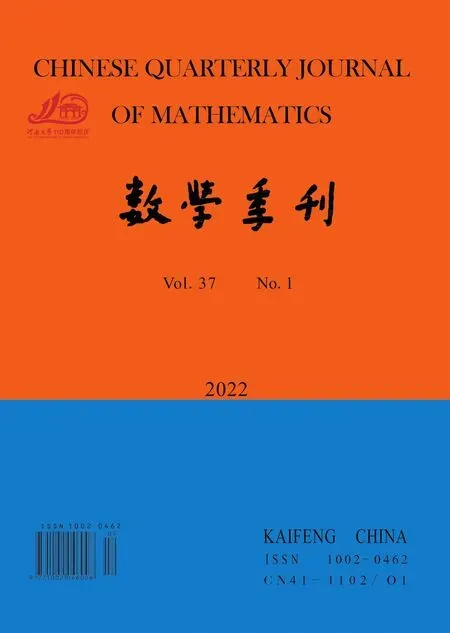Well-Posedness for Timoshenko System with Thermodiffusion Effects and Delay
2022-04-13
(Department of Mathematics,Donghua University,Shanghai 201620,China)
Abstract:In this paper,we study the well-posedness for the thermoelastic Timoshenko system with a constant delay and mass diffusion effects.Heat and mass exchange with the environment during thermodiffusion in Timoshenko beam.The C0-semigroup theory will be used to prove the well-posedness of the considered problem.
Keywords:Timoshenko system;Well-posedness;Delay;C0-semigroup theory
§1.Introduction
In 1921,a simple model describing the transverse vibration of a beam,which was developed in[13],is given by a system of coupled hyperbolic equation of the form

wheretdenotes the time variable,xis the space variable along the beam of lengthL,in its equilibrium configuration,uis the transvers displacement of the beam andφis the rotation angle of the filament of the beam.The coefficientsρ,Iρ,E,IandKare the density(the mass per unit length),the polar moment of inertia of a cross section,Young’s modulus of elasticity,the moment of inertia of across section,and the shear modulus respectively.
Kim and Renardy[7]considered(1.1)together with two boundary control of the form

and used the multiplier techniques to establish an exponential decay result for the natural energy of(1.1).
For stabilization via heat dissipation,Rivera and Racke[11]considered

whereφ,ψ,θare functions of(x,t)which denote the transverse displacement of the beam,the rotation angle of the filament and the difference temperature,respectively.Under appropriate conditions ofσ,ρi,b,k,r,they established global existence of solutions and exponential decay results for Timoshenko systems coupled with the classical heat equation.
We may think that the dissipation phenomenon cannot only be described by thermal conduction in Timoshenko beams.However,the research conducted in the development of high technologies after the second world war confirmed that the field of diffusion in solids cannot be ignored.Therefore,the obvious question is:what happens when the diffusion effect is considered with the thermal effect in Timoshenko beams.Hence,diffusion can be defined as the random walk of a set of particles from regions of high concentration to regions of lower concentration.Thermodiffusion in an elastic solid is due to the coupling of the fields of strain,temperature and mass diffusion.The processes of heat and mass diffusion play an important role in many engineering applications.
In[1],the mass diffusion is taken into account in the Timoshenko equation.The system is given:

andPis the chemical potential,ħ>0 is the diffusion coefficient,ϖis a measure of the thermodiffusion effect and is a measure of the diffusive effect.
Time delays arise in many applications because most phenomena naturally depend not only on the present state but also on some past occurrences.In recent years,the control of PDEs with time delay effects has become an active area of research.So,we will study the following system:

§2.Preliminaries
In order to obtain the well-posedness of the problem(1.6),consider the following change of variable

§3.Well-posedness
In this section,we give the existence and uniqueness result for problem(2.3)using the semigroup theory,we will use the following standardL2(0,1)space with the scalar product and norm denoted by

Introducing the vector functionU(t)=(φ,u,ψ,v,θ,P,z)T,whereu=φt,v=ψt,U(0)=(φ0,φ1,ψ0,ψ1,θ0,P0,f0)T.Thus,the system(2.3)can be rewritten as

Thus,Ais monotone.
Next,we prove that the operatorI−Ais onto.Obviously,it is not so difficult to prove thatR(I−A)=H,whereR(I−A)stands for range of the operatorI−A.i.e.GivenG=(g1,g2,g3,g4,g5,g6,g7)T∈H,we prove that there exists a uniqueU∈D(A)such that


for some constantm0>0.Thus B is coercive.On the other hand,using Cauchuy-Schwarz’s inequality and Poincar´e’s inequality,we obtain

杂志排行
Chinese Quarterly Journal of Mathematics的其它文章
- Finite Time Blowup with Upper Bound of Blowup Time of Solutions to Semilinear Parabolic Equations with General Nonlinearity
- Parameter Conditions for Hilbert-Type Operator Bounded with Homogeneous Kernels between Sequence Space l and Function Space L
- Two Embedding Theorems in Martingale Spaces
- Expressions of Two Classes of Infinite Series in Terms of Bernoulli Numbers
- A Note on the Representation of an Integer in Two Different Bases
- Spatial Decay Estimates for the Solutions to Stokes Equations in Four Kinds of Semi-Infinite Cylinders
